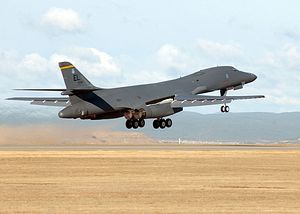What is the LRS-B for? Conflicting reports have emerged over the likely cost of the USAF’s next generation bomber. Last week, the Lieutenant General Charles Davis (USAF) acknowledged that the per unit price for the new stealth bomber will climb from $550 million to $810 million, taking into account research and production costs. A later press release insisted that the USAF remains committed to the $550 million target. Given that the B-1B cost twice the estimated development pricetag, and the B-2 nearly triple, it’s not at all unreasonable to suggest that we’ll reach a $1 billion per plane cost by the time the program gets up and running.
This brings us back to the question: What requirement does the LRS-B fill? Much like the B-2 Spirit, it promises to provide long range strike options into contested areas, presumably against highly advanced air defense networks. The most obvious potential opponent for the LRS-B is China, which remains in the process of developing an integrated, sophisticated system of anti-access systems. The new bomber will also presumably replace legacy bomber aircraft, including the B-52, B-2 and the B-1B, on the various missions that they perform. These include everything from maritime strike, to interdiction, to close air support, to nuclear deterrence, to general intimidation.
Is this the best strike option? This depends on what we compare it to. Submarine launched cruise missiles and stealth drones leap to mind as potential competitors for the mission of a long range strike into contested areas. The LRS-B offers a manned bomber (although it reportedly will include an unmanned option) capable of delivering large payloads to multiple targets. Depending on how unobservable the bomber proves, this could offer some first strike or in-conflict options that the United States doesn’t already have, although it’s reasonable to ask how much of an additional capability the U.S. requires over and above what the B-2 currently offers.
Globally, the dedicated bomber is an endangered species. Apart from the PAK DA, a Russian bomber project that will likely never see service, the LRS-B would be the only bomber in production anywhere in the world. Indeed, since the last B-2 entered service in 1997, no country has constructed any large bomber aircraft. Multirole fighter bombers have displaced the large bomber in nearly every air force. The PLAAF and the Russian Air Force have largely contented themselves with refurbishing and updating older models, including the H-6 (a development of the Tu-16), the Tu-95, and the Tu-22M. Again with the exception of the PAK DA, no other large, dedicated bomber is even on the drawing board. No country besides the United States, with its enduring vision of global power supported by global reach, sees much of a need for the long-range strike capabilities that manned bombers present.
If technological shifts render the LRS-B somewhat more observable, then we’re spending $810 billion+ on a bomber that will essentially perform the same mission as the B-1B and the B-52, just more slowly and at dramatically higher cost. Given the success that the USAF (and its Russian counterpart) have enjoyed in maintaining and updating Cold War legacy bombers, it seems a stretch to argue that a capabilities gap will emerge that only the LRS-B can fill. Finally, the LRS-B represents one part of an answer to a very specific vision of American foreign policy, a vision that emphasizes the unique capacity of the U.S. to intervene anywhere, anytime, with decisive military force. It’s worth wondering whether that vision will persist for as long as the bombers themselves.

































